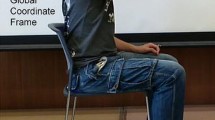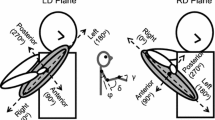Abstract
This paper examines up to third-order geometric properties of wrist path and the first-order property of wrist trajectory (wrist speed) for spatial pointing movements. Previous studies report conflicting data regarding the time invariance of wrist-path shape, and most analyses are limited to the second-order geometric property (straightness, or strictly speaking, curvature). Subjects performed point-to-point reaching movements between targets whose locations ensured that the wrist paths spanned a range of lengths and lay in various portions of the arm’s spatial workspace. Movement kinematics were recorded using electromagnetic sensors located on the subject’s arm segments and thorax. Analysis revealed that wrist paths tend to lie in planes and to curve more as movement speed decreases. The orientation of the wrist-path plane depends on the reaching task but does not vary significantly with movement speed. The planarity of wrist paths indicates that the paths have close to zero torsion—a third-order geometric property. Wrist-speed profiles showed multiple peaks for sufficiently slow and long lasting movements, indicating deviation from the well-known, bell-shaped profile. These kinematic findings are discussed in light of various motor control theories.






Similar content being viewed by others
Notes
Tasks 6 and 7 and Tasks 3 and 8 are similar. The wrist paths of these two sets of movements are similar, and so Tasks 7 and 8 are not included in the data analysis of this paper.
The rate of curvature change with respect to the arc length is the ‘in-plane’ third-order geometric property of a curve. This property has not been studied in this work or elsewhere in the motor control/biomechanics literature. Together with torsion, it provides a complete third-order local characterization of a spatial curve.
References
Adamovich SV, Berkinbilt MB, Fookson O, Poizner H (1999) Pointing in 3D space to remembered targets. II: effects of movement speed toward kinesthetically defined targets. Exp Brain Res 125:200–210
Ambike SS (2011) Characteristics of spatial human arm motion and the kinematic trajectory tracking of similar serial chains. Dissertation, The Ohio State University
Ambike S, Schmiedeler JP (2006) Modeling time invariance in human arm-motion coordination. In: Lenarčič J, Roth B (eds) Advances in robot kinematics. Springer, Dodrecht, pp 177–184
Ambike S, Schmiedeler JP (2013) The leading joint hypothesis for spatial reaching arm motions. Exp Brain Res 224:591–603
Atkeson CG (1989) Learning arm kinematics and dynamics. Ann Rev Neurosci 12:157–183
Atkeson CG, Hollerbach JM (1985) Kinematic features of unrestrained vertical arm movements. J Neurosci 5:2318–2330
Bernstein NA (1967) The coordination and regulation of movement. Pergamon, New York
Breteler MDK, Meulenbroek RGJ, Gielen SCAM (1998) Geometric features of workspace and joint-space paths of 3D reaching movements. Acta Psychol 100:37–53
Conditt MA, Mussa-Ivaldi FA (1999) Central representation of time during motor learning. Proc Natl Acad Sci 96:11625–11630
Conditt MA, Gandolfo F, Mussa-Ivaldi FA (1997) The motor system does not learn the dynamics of the arm by rote memorization of past experience. J Neurophysiol 78:554–560
Dounskaia N (2007) Kinematic invariants during cyclical arm movements. Biol Cybern 96:147–163
Dounskaia N, Wiselder D, Johnson T (2005) Influence of biomechanical factors on substructure of pointing movements. Exp Brain Res 164:505–516
Engström DA, Kelso JAS, Holroyd T (1996) Reaction-anticipation transitions in human perception-action cycles. Human Movement Sci 15:809–832
Feldman AG (1986) Once more for the equilibrium-point hypothesis (lambda model) for motor control. J Mot Behav 18:17–54
Feldman AG (2011) Space and time in the context of equilibrium-point theory. Wiley Cogn Sci 2:287–304
Flanders M, Herrmann U (1992) Two components of muscle activation: scaling with the speed of arm movement. J Neurophysiol 67:931–943
Flash T, Hogan N (1985) The coordination of arm movements: an experimentally confirmed mathematical model. J Neurosci 5:1688–1703
Gentili R, Cahouet V, Papaxanthis C (2007) Motor planning of arm movements is direction-dependent in the gravity field. Neuroscience 145:20–32
Haggard P, Richardson J (1985) Spatial patterns in the control of human arm movement. J Exp Psych 22:42–62
Hollerbach JM, Flash T (1982) Dynamic interactions between limb segments during planar arm movement. Biol Cybern 44:67–77
Isenberg C, Conrad B (1994) Kinematic properties of slow arm movements in Parkinson’s disease. J Neurol 241:323–330
Ivry RB, Hazeltine RE (1994) Perception and production of temporal intervals across a range of durations: evidence for a common timing mechanism. J Exp Psych 21:3–18
Jones T (1968) Statistical analysis of orientation data. J Sediment Petrol 38:61–67
Kawato M (1999) Internal models for motor control and trajectory planning. Curr Opin Neurobiol 9:718–727
Lacquaniti F, Terzuolo C, Viviani P (1983) The law relating the kinematic and figural aspects of drawing movements. Acta Psychol 54:115–130
Liao M, Jagacinski RJ, Greenberg N (1997) Quantifying the performance limitations of older and younger adults in a target acquisition task. J Exp Psych 23:1644–1664
Loeb GE (2012) Optimal isn’t good enough. Biol Cybern 106:757–765
Messier J, Adamovich S, Berkinblit M, Tunik E, Poizner H (2003) Influence of movement speed on accuracy and coordination of reaching movements to memorized targets in three-dimensional space in a deafferented subject. Exp Brain Res 4:399–416
Meyer DE, Abrams RA, Kornblum S, Wright CE (1988) Optimality in human motor performance: ideal control of rapid aimed movements. Psych Rev 95:340–370
Meyer DE, Smih JEK, Kornblum S, Abrams RA, Wrisht CE (1990) Speed-accuracy tradeoffs in aimed movement: toward a theory of rapid voluntary action. In: Jeannerod M (ed) Attention and performance XIII. Lawrence Erlbaum Associates, New Jersey, pp 172–226
Morasso P (1981) Spatial control of arm movements. Exp Brain Res 42:223–227
Nishikawa KC, Murray ST, Flanders M (1999) Do arm postures vary with the speed of reaching? J Neurophysiol 81:2582–2586
Papaxanthis C, Pozzo T, Schieppati M (2003) Trajectories of arm pointing movements on the sagittal plane vary with both direction and speed. Exp Brain Res 148:498–503
Papaxanthis C, Pozzo T, McIntyre J (2005) Kinematic and dynamic processes for the control of pointing movements in humans revealed by short-term exposure to microgravity. Neuroscience 135:371–383
Prilutsky B, Zatsiorsky V (2002) Optimization-based models of muscle coordination. Exerc Sports Sci Rev 30:1–13
Schaal S, Sternad D (2001) Origins and violations of the 2/3 power law in rhythmic three-dimensional arm movements. Exp Brain Res 136:60–72
Soechting JF, Lacquaniti F (1981) Invariant characteristics of a pointing movement in man. J Neurosci 1:710–720
Soechting JF, Lacquaniti F, Terzuolo CA (1986) Coordination of arm movements in three-dimensional space. Sensorimotor mapping during drawing movement. Neuroscience 17:295–311
Soechting JF, Buneo CA, Herrmann U, Flanders M (1995) Moving effortlessly in three dimensions: does Donder’s law apply to arm movement? J Neurosci 15:6271–6280
Soechting JF, Gordon AM, Engel KC (1996) Sequential hand and finger movements: typing and piano playing. In: Bloedel JR, Ebner TJ, Wise SP (eds) Acquisition of motor behavior in vertebrates. MIT Press, Cambridge
Todorov E (2004) Optimality principles in sensorimotor control. Natl Neurosci 7:907–915
Viviani P, Terzuolo C (1982) Trajectory determines movement dynamics. Neuroscience 7:431–437
van der Wel PRD, Sternad D, Rosenbaum DA (2010) Moving the arm at different rates: slow movements are avoided. J Motor Behav 42:29–39
Wolpert DM, Ghahramani Z, Jordan MI (1995) Are arm trajectories planned in kinematic or dynamic coordinates? An adaptation study. Exp Brain Res 103:460–470
Wua G, van der Helm FCT, Veeger HEJ, Makhsouse M et al (2005) ISB recommendation on definitions of joint coordinate systems of various joints for the reporting of human joint motion—part II: shoulder, elbow, wrist and hand. J Biomech 38:981–992
Yadav V (2010) Validation of a time-scaling-based model for representation of dynamics in humans and its applications in rehabilitation. Dissertation, The Ohio State University
Zar JH (1999) Biostatistical analysis. Prentice Hall, New Jersey
Acknowledgments
Support was provided by grant no. IIS-0937612 from the National Science Foundation. The authors wish to thank Mr. Julian Corona for his assistance in data collection, and the reviewers of this paper for their insightful comments.
Author information
Authors and Affiliations
Corresponding author
Rights and permissions
About this article
Cite this article
Ambike, S., Schmiedeler, J.P. Invariant geometric characteristics of spatial arm motion. Exp Brain Res 229, 113–124 (2013). https://doi.org/10.1007/s00221-013-3599-9
Received:
Accepted:
Published:
Issue Date:
DOI: https://doi.org/10.1007/s00221-013-3599-9




